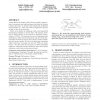Free Online Productivity Tools
i2Speak
i2Symbol
i2OCR
iTex2Img
iWeb2Print
iWeb2Shot
i2Type
iPdf2Split
iPdf2Merge
i2Bopomofo
i2Arabic
i2Style
i2Image
i2PDF
iLatex2Rtf
Sci2ools
87
Voted
SIGMETRICS
2004
ACM
2004
ACM
Quantifying trade-offs in resource allocation for VPNs
Virtual Private Networks (VPNs) feature notable characteristics in structure and traffic patterns that allow for efficient resource allocation. A strategy that exploits the underlying characteristics of a VPN can result in significant capacity savings to the service provider. There are a number of admission control and bandwidth provisioning strategies to choose from. We examine tradeoffs in design choices in the context of distinctive characteristics of VPNs. We examine the value of signaling-based mechanisms, traffic matrix information and structural characteristics of VPNs in the way they impact resource utilization and service quality. We arrive at important conclusions which could have an impact on the way VPNs are architected. We show that the structure of VPNs profoundly influences achievable resource utilization gains with various admission control and provisioning schemes. Categories and Subject Descriptors: C.2.1 [ComputerCommunication Networks]: Network Architecture and ...
Admission Control | SIGMETRICS 2004 | VPNs | Way Vpns |
| Added | 30 Jun 2010 |
| Updated | 30 Jun 2010 |
| Type | Conference |
| Year | 2004 |
| Where | SIGMETRICS |
| Authors | Satish Raghunath, Shivkumar Kalyanaraman, K. K. Ramakrishnan |
Comments (0)

